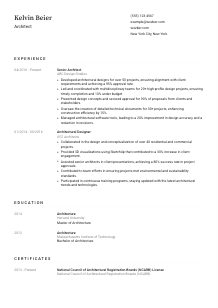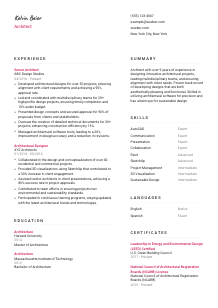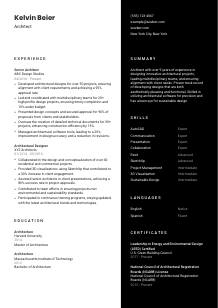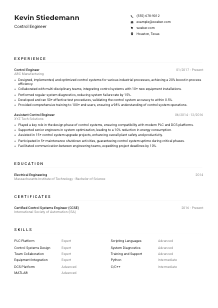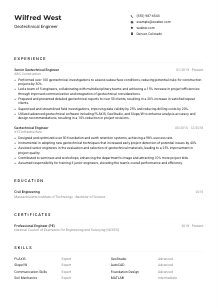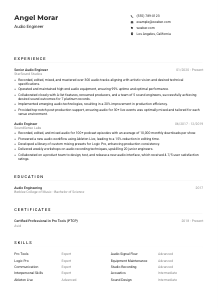Architect Resume Example
Crafting blueprints, but your resume doesn't stand out in the skyline? Elevate your credentials with this Architect resume example, designed using Wozber free resume builder. Grasp how to structure your visionary skills to align with job specifications, constructing a career as remarkable as your creations!
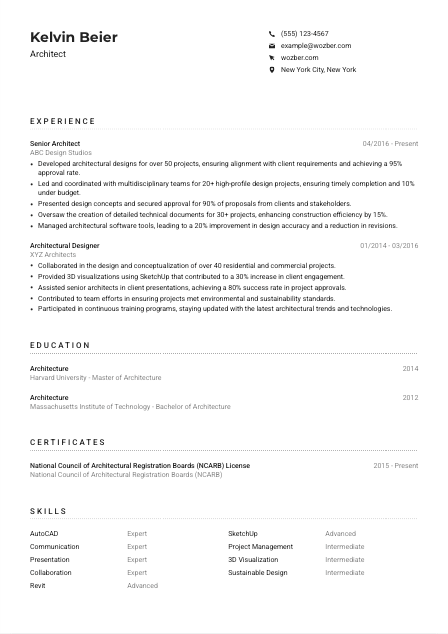
How to write an Architect resume?
Hello, future Architect par excellence! In a realm where your creations speak volumes, your resume must echo the same level of precision and innovation. This isn't just about aligning blocks but constructing a narrative that showcases your prowess in architecture. Using the Wozber free resume builder, this guide is tailored explicitly for you, aiming to bridge your skills with the aspirations of your dream job.
Ready to sketch out your professional blueprint? Let's dive into creating a resume that not only meets but exceeds the expectations of the Architectural sphere!
Personal Details
The foundation of every great resume begins with personal details. This section might seem a mere formality, yet it's the cornerstone of your first impression. Let's navigate through the personal details with an architectural lens, sculpting them to showcase you're not just an applicant but the Architect they've been searching for.
1. Your Name as Your Brand
Consider your name the facade of your professional edifice. It should be bold, clear, and immediately recognizable. Opt for a clean, legible font that stands out, much like the distinctive entrance to a well-designed building.
2. Specificity in Job Title
"Architect" should be prominently featured just below your name, mirroring the job title. This acts as a clear signpost, directing the hiring manager's attention to your relevant qualifications right from the onset.
3. Essential Contact Info
Ensure your phone number and professional email address are present and correct. A minor typo could mean a missed connection. Also, consider including a LinkedIn profile or an online portfolio link showcasing your projects; this is akin to offering a peek inside your previous works.
4. Geographical Alignment
Highlighting "New York City, New York" aligns you with one of the job's prerequisites, immediately addressing any concerns about availability or relocation. It's about being in the right place at the right time.
5. Professional Profiles
Adding a personal website or online portfolio offers a live exhibition of your work, functioning like an open house for your professional accomplishments. Ensure that these profiles are polished mirrors of your resume, providing a cohesive narrative of your architectural journey.
Takeaway
Your personal details should create an inviting entrance into your resume, similar to an impressive lobby that beckons further exploration. Keep this section clear, accurate, and reflective of your professional identity. It's the blueprint for the first impression you'll make, so ensure every detail is in its perfect place.





Experience
Like the robust structure of a well-designed building, your experience section must stand on a strong foundation of relevant contributions and achievements. Here, it's not just about what you've done, but how you've elevated each project or role with your architectural vision and expertise.
- Developed architectural designs for over 50 projects, ensuring alignment with client requirements and achieving a 95% approval rate.
- Led and coordinated with multidisciplinary teams for 20+ high‑profile design projects, ensuring timely completion and 10% under budget.
- Presented design concepts and secured approval for 90% of proposals from clients and stakeholders.
- Oversaw the creation of detailed technical documents for 30+ projects, enhancing construction efficiency by 15%.
- Managed architectural software tools, leading to a 20% improvement in design accuracy and a reduction in revisions.
- Collaborated in the design and conceptualization of over 40 residential and commercial projects.
- Provided 3D visualizations using SketchUp that contributed to a 30% increase in client engagement.
- Assisted senior architects in client presentations, achieving a 80% success rate in project approvals.
- Contributed to team efforts in ensuring projects met environmental and sustainability standards.
- Participated in continuous training programs, staying updated with the latest architectural trends and technologies.
1. Understanding the Framework
Begin by dissecting the job description to identify keywords and themes. For instance, words like 'project management' and 'multidisciplinary teams' should find their resonance in your experience section, laying the groundwork for a compelling narrative.
2. Structuring Your Contributions
Chronological order is your friend, allowing the reader to navigate your professional development like a clear, well-planned blueprint. Highlight each position held, the firm name, and the tenure, ensuring these are laid out in an easy-to-follow format.
3. Highlighting Achievements
Each role you list should be accompanied by bullet points showcasing your impact. Did your designs win awards? Did your efficiency improvements lead to cost savings? Quantify these achievements to provide concrete footing to your claims.
4. Numbers Speak Volumes
Quantifying your accomplishments gives scale to your achievements, much like the dimensions in architectural schematics. Whether it's the percentage by which you reduced costs or the number of projects you spearheaded, these metrics add depth and perspective.
5. Relevance Is Key
While your stint as a part-time barista might show versatility, focus on relevant architectural experiences. Think of your resume as a curated exhibit of your professional life, displaying only the most relevant and impressive pieces.
Takeaway
Crafting an impactful experience section is akin to constructing the core of your building. It must be sturdy, reliable, and showcase the best of your architectural abilities. Tailor each point to match the job's requirements, using clear, quantifiable achievements to demonstrate your suitability and excellence.
Education
In the world of architecture, your educational background is like the foundation of your career. It substantiates your qualifications and prepares you for the practical challenges of the profession. Let's sculpt this section to reflect the robust educational pillars supporting your career edifice.
1. Pinpoint the Blueprint
Firstly, identify the key educational requirements highlighted in the job description. The demand for a 'Bachelor's or Master's degree in Architecture from an accredited institution' should be prominently reflected in your education section.
2. Constructing the Details
Lay out your educational credentials in a straightforward manner - degree, field of study, institution, and graduation year. This information builds the foundation of your professional qualifications.
3. Specificity Matters
If the position demands particular degrees or certifications, ensure these are highlighted. For our Architect example, a ‘Master of Architecture in Architecture' directly addresses a primary requirement, reinforcing your eligibility.
4. Additional Layers
While the main structure of your education section is set, consider adding layers like relevant coursework, honors, or extracurricular activities that underline your passion and dedication to architecture.
5. Evolving Education
Architecture, like any artistic field, constantly evolves. Mention any relevant ongoing education, workshops, or seminars that keep your knowledge on the cutting edge, showing your commitment to continuous improvement.
Takeaway
Your education section should reflect the strong, essential foundation upon which your architectural career is built. It's not just about the degrees, but the story they tell of your dedication, growth, and evolving expertise in the field.
Certificates
Certificates in the architecture world are not just accolades; they are testimony to your commitment to professional growth and adherence to industry standards. Let's leverage this section to further solidify your qualifications.
1. Foundation Stones
Begin by identifying the certificates directly mentioned in the job requirements. Our Architect role specifically asks for an 'NCARB License.' Hence, this certificate should be prominently displayed, serving as a key pillar of your qualification.
2. Selective Showcasing
Focus on certificates that are most relevant to the job at hand. This ensures that the hiring manager's attention is immediately drawn to your qualifications that directly correlate with the job's requirements.
3. Date Stamps
Where applicable, include the acquisition dates of your certificates, especially if they are recent or require renewal. This not only shows your up-to-date compliance but also your proactive approach to professional development.
4. Continuous Learning
The architectural field is always advancing, be it through sustainable design practices or new software technologies. Highlight your commitment to staying current by listing recent or ongoing certificate programs.
Takeaway
Your collection of certificates is a gallery of your continuous learning and professional enrichment. Selectively display these accolades to emphasize their relevance to the Architectural role you're aspiring for. Let each certificate narrate a part of your professional journey.
Skills
An Architect's skill set is the toolbox that enables the creation of functional art. This section is your opportunity to showcase the hard and soft skills that you bring to the drafting table. Let's craft a compelling tableau that highlights your top skills.
1. Extracting the Essentials
Review the job description closely to identify both the stated and implicit skills required. Skills like 'proficiency in architectural software' and 'strong communication' are your keywords. These should be iconically featured, just as a signature element would in a building design.
2. Prioritizing Architecture-Specific Skills
Match your skills with those listed in the job requirements. For example, expertise in "AutoCAD, Revit, and SketchUp" is a direct response to the job's demands, underlining your competency in essential architectural tools.
3. Balancing Hard and Soft Skills
Just like balancing the aesthetic with the functional in architecture, ensure your skills section harmonizes hard skills with soft skills. Demonstrate not only your technical proficiencies but also your ability to collaborate, communicate, and lead projects.
Takeaway
Consider the Skills section as the display window of your professional storefront, highlighting your most valuable and relevant tools. Each skill you list is a commitment to excellence and a testament to why you're the perfect fit for the Architect role. Curate this section with care, ensuring a balanced showcase of what you bring to the drafting table.
Languages
In our increasingly globalized world, linguistic skills can greatly enhance your architectural portfolio, especially when projects cross cultural boundaries. Whether you're collaborating internationally or locally in a multilingual city like New York, your language skills can set you apart.
1. Matching Job Specs
The job description highlights 'English proficiency' as a key requirement. Ensure this is prominently featured, reassuring the hiring manager of your ability to communicate effectively in the project's primary language.
2. Detailing Linguistic Proficiency
Clearly categorize your language proficiencies: native, fluent, intermediate, or basic. This clarity will help hiring managers understand how seamlessly you can integrate into diverse teams or handle projects in different locales.
3. The Global Architect
Even if not explicitly mentioned, listing additional languages you speak can be a significant advantage, especially in a city as culturally diverse as New York. It speaks to your versatility and readiness to engage with a broad spectrum of clients and collaborators.
4. Honesty in Proficiency
Be truthful about your language levels. Misrepresenting your proficiency could lead to miscommunications, affecting project outcomes and professional relations. Honesty will always be your best policy.
5. The Role's Global Reach
While our Architect job may be New York-based, projects often have global implications. Your language skills can be a compelling indicator of your ability to navigate international projects or collaborations.
Takeaway
Your language skills are not just personal attributes; they're professional tools that enhance your architectural toolkit. Flaunt them with pride, and let them showcase your readiness for diverse projects and collaborations. Languages are not merely spoken; they are experienced, opening doors to new opportunities and connections.
Summary
Your summary is the vestibule through which hiring managers enter your professional narrative. This brief section must encapsulate your core strengths, experiences, and the unique attributes you bring to the table. Let's draft a compelling entry that invites readers to explore further.
1. The Essence of Your Practice
Start by distilling the essence of what makes you a unique Architect. Reflect on the job requirements and align your summary to address these points succinctly.
2. A Strong Opening Line
Introduce yourself with a statement that captures your professional identity. For example, 'Architect with over 9 years of experience in designing innovative architectural projects' immediately conveys your experience level and area of expertise.
3. Core Competencies
Briefly list your key skills and accomplishments that make you a prime candidate for the position. These should mirror the job description, reinforcing your candidacy.
4. The Elevator Pitch
Remember, the summary is your elevator pitch, not a detailed account. Keep it precise, targeting 3-5 impactful lines that leave hiring managers eager to learn more about you and your architectural journey.
Takeaway
Crafting a strategic summary is like designing the entrance to a building. It sets the tone, invites further exploration, and reflects the essence of what lies within. With a concise, targeted summary, you'll open the door to opportunities, beckoning the hiring manager to delve deeper into your professional portfolio.
Launching Your Architect Journey
Congratulations, Architect! You've meticulously crafted each section of your resume, aligning it with the beams and columns of the job you're aspiring to. With a resume sculpted through the Wozber free resume builder - featuring ATS-compliant resume formats and the precision of the ATS resume scanner - you're not just ready; you're a standout contender in the architectural realm. Remember, your resume is more than a document; it's a testament to your passion and dedication to architecture.
Now, take this blueprint of success, and stride confidently towards your next project. Your dream role awaits, and the world is ready to be shaped by your designs. Best of luck!

- Bachelor's or Master's degree in Architecture from an accredited institution.
- Minimum of 5 years of professional experience in architectural design and project management.
- Proficiency in architectural software, including AutoCAD, Revit, and SketchUp.
- Strong communication, presentation, and collaboration skills to effectively liaise with clients, contractors, and team members.
- License from the National Council of Architectural Registration Boards (NCARB) or the ability to obtain within 6 months.
- English proficiency is a fundamental requirement.
- Must be located in New York City, New York.
- Develop architectural designs for projects, ensuring alignment with client requirements and industry standards.
- Manage and coordinate with multidisciplinary project teams throughout the design and construction phases.
- Present design proposals and concepts to clients and stakeholders for approval.
- Oversee the creation of detailed technical documents and specifications for construction.
- Ensure projects are completed on time, within budget, and to the highest quality standards.





